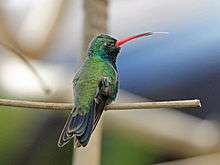Broad-billed hummingbird
| Broad-billed hummingbird | |
|---|---|
 | |
| Scientific classification | |
| Kingdom: | Animalia |
| Phylum: | Chordata |
| Class: | Aves |
| Order: | Apodiformes |
| Family: | Trochilidae |
| Genus: | Cynanthus |
| Species: | C. latirostris |
| Binomial name | |
| Cynanthus latirostris Swainson, 1827 | |
| | |
| Extent of occurrence | |
The broad-billed hummingbird (Cynanthus latirostris) is a medium-sized hummingbird of North America. It is 9–10 cm long, and weighs approximately three to four grams.
Distribution
The breeding habitat is in arid scrub of the Sonoran Desert—Chihuahuan Desert ecotone and the Madrean Sky Islands in southeastern Arizona and extreme southwestern New Mexico of the Southwestern United States and northern Sonora of Northwestern Mexico.
Outside its breeding range, it will occasionally stray, from southernmost California to Texas and Louisiana.
Description
Adults are colored predominantly a metallic green on their upperparts and breast. The undertail coverts are predominantly white. The tail is darkly colored and slightly forked.
The bill of the male is straight and very slender. It is red in coloration, and shows a black tip. His throat is a deep blue. The female is less colorful than the male. She usually shows a white eye stripe.
The female builds a nest in a protected location in a shrub or tree. Females lay two white eggs. This hummingbird is partially migratory, retreating from northernmost areas during the winter to Central Mexico.
These birds feed on nectar from flowers and flowering trees using a long extendable tongue, or catch insects on the wing.
References
- ↑ BirdLife International (2012). "Cynanthus latirostris". IUCN Red List of Threatened Species. Version 2013.2. International Union for Conservation of Nature. Retrieved 26 November 2013.

